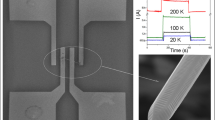Abstract
A maskless method of employing polymer growth inhibitor layers is used to modulate the conflicting parameters of density and alignment of multi-junction nanowires via large-scale low temperature chemical route. This low temperature chemical route is shown to synthesize multi-junction nanostructures without compromising the crystal quality at the interfaces. The final morphology of an optimized multi-junctions nanowire arrays can be demonstrated on various substrates due to substrate independence and low temperature processing. Here, we also follow-up on device demonstrations whereby p-n junction are created by exposure of secondary nanowires to ammonia plasma, converting them to p-type characteristics and also the density modulated multi-junction nanowires were tuned to infiltrate nanoparticles to create a hybrid hierarchically-structured nanowire/nanoparticles solar cell. The fabrication of hierarchically-structured nanowire/nanoparticles composites presents an advantageous structure, one that allow nanoparticles to provide large surface areas for the dye adsorption, whilst the nanowires can enhance the light harvesting, electron transport rate, and also the mechanical properties of the films. This work can be of great scientific and commercial interest since the technique employed is of low temperature (< 90 °C) and economical for large-scale solution processing, much valued in today’s flexible display and photovoltaic industries. In addition, ZnO nanostructures for gas sensing will be presented.
Similar content being viewed by others
References
Liu, T. Y.; Liao, H. C.; Lin, C. C.; Hu, S. H.; Chen, S. Y. Langmuir 2006, 22, 5804.
Yang, P. D.; Yan, H. Q.; Mao, S.; Russo, R.; Johnson, J.; Saykally, R.; Morris, N.; Pham, J.; He, R. R.; Choi, H. J. Adv. Funct. Mater. 2002, 12, 323.
Wang, X. D.; Song, J. H.; Summers, C. J.; Ryou, J. H.; Li, P.; Dupuis, R. D.; Wang, Z. L. J. Phys. Chem. B 2006 , 110, 7720.
Song, J. J.; Lim, S. W. J. Phys. Chem. C 2007, 111, 596.
Ma, T.; Guo, M.; Zhang, M.; Zhang, Y. J.; Wang, X. D. Nanotechnology 2007, 18, 035605.
Kevin, M.; Fou, Y. H. ; Wong A. S.W. and Ho G. W. Nanotechnology 2010, 21, 315602.
Law, M.; Greene, L. E.; Johnson, J. C.; Saykally, R.; Yang, P. Nat. Mater., 2005, 4, 455. 15–28.
J.X. Wang, X.W. Sun, Y. Yang, H. Huang, Y.C. Lee, O.K. Tan and L. Vayssieres, Nanotechnology, 2006, 17, 4995.
Author information
Authors and Affiliations
Rights and permissions
About this article
Cite this article
Kevin, M., Ong, W.L. & Ho, G.W. Multi-junction ZnO Nanowires for Enhanced Surface Area and Light Trapping Solar Cells and Room Temperature Gas Sensing. MRS Online Proceedings Library 1350, 915 (2011). https://doi.org/10.1557/opl.2011.1518
Published:
DOI: https://doi.org/10.1557/opl.2011.1518




